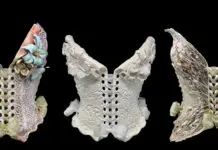Have you ever poked around in the basement and noticed shipping labels or strange stencil marks on the beams? Have you discovered a mysterious set of blueprints in your attic? Do you live near a railroad line? If so, it’s possible your house might have been a mail-order home.
For around the first half of the 20th century, a variety of companies – most famously Sears, but also Montgomery Ward, Aladdin, Gordon Van Tine and others – offered build-your-own-home kits. Every single piece needed to construct a dream home, from pantry to patio, were shipped via boxcar to your future doorstep. Houses came in a wide variety of sizes and styles, from modest bungalows to columned mansions. And if you think housing prices have fallen in the past few years, they have nothing on real estate during the heyday of the mail-order house: Many kit homes were available for under $3,000.
According to Lynda Ozan, architectural historian for the Oklahoma State Historic Preservation Office, kit houses made the home-owning dreams of the working classes come true.
“Kit houses were appealing to the working class because of the price,” she says, “but that is not to say that they were ‘cheap,’ or inferior, houses. They were economical because there were not overages; the house has been streamlined so that the appropriate amount of material is included.” In addition to the lure of affordability, she says mail-order houses also offered the perfect chance to establish a home in the newly growing suburbs as urban centers became crowded and polluted.
“Kit homes gave people the opportunity for home ownership that regular construction didn’t,” says retired firefighter Rachel Shoemaker, whose blog chronicles her personal quest to discover these little-known pieces of architectural history. “They were extremely nice houses and came in a variety of sizes and styles – not to mention the materials were the best. They were money saving and time saving. Think about it: everything you needed – lumber, windows, doors, hardware, trim, paint, even the nails – were included, as well as blueprints and an instruction booklet. If you built the house yourself, you saved labor costs for hiring a carpenter. You didn’t need any special equipment or skills; all you needed was a hammer, basically.”
According to Ozan, there are several confirmed kit homes in Oklahoma, including a Colonial Revival style house in Chelsea, two homes in Stillwater, and another in Bartlesville. Shoemaker also has made it her personal quest to identify mail-order homes across the state, and has confirmed kit homes from Tulsa to Enid.
“I have always loved old houses; they spark an interest in how people lived,” she explains of her fascination with mail-order homes. She describes her search for kit homes as her personal adventure.
“It is mystery. And it’s like a treasure hunt. It’s an important part of Americana, and an unknown part or undocumented part of Americana here.”


























